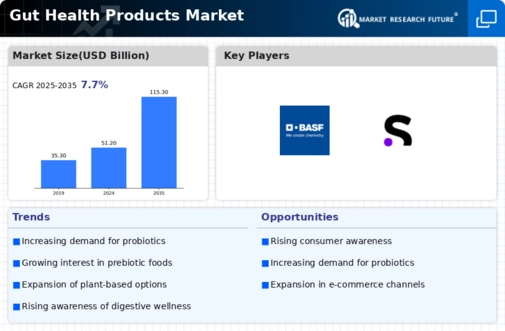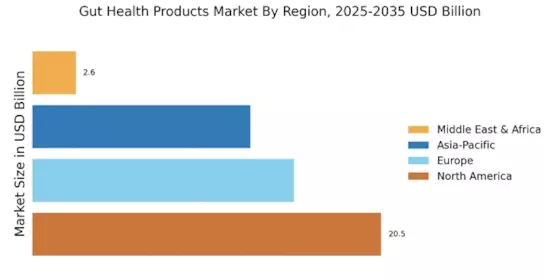Emphasis on Preventive Healthcare
The growing emphasis on preventive healthcare is a significant driver for the Gut Health Products Market. As consumers increasingly prioritize health maintenance over treatment, there is a notable shift towards products that support gut health as a preventive measure. This trend is reflected in the rising demand for supplements and functional foods that promote digestive wellness. Research indicates that consumers are willing to invest in products that enhance their overall health, with a particular focus on gut health. This proactive approach to health management is likely to continue influencing consumer behavior, leading to sustained growth in the Gut Health Products Market. The focus on prevention rather than cure is reshaping the landscape of health and wellness, positioning gut health products as essential components of a healthy lifestyle.
Innovations in Product Formulation
Innovations in product formulation are driving advancements within the Gut Health Products Market. Manufacturers are increasingly focusing on developing unique formulations that enhance the efficacy of gut health products. This includes the incorporation of novel ingredients, such as plant-based probiotics and prebiotics, which are gaining traction among health-conscious consumers. Furthermore, advancements in technology are enabling the creation of more effective delivery systems, ensuring that beneficial ingredients reach the gut effectively. The market is witnessing a surge in products that cater to specific dietary needs, such as gluten-free or vegan options. These innovations not only attract a broader consumer base but also contribute to the overall growth of the Gut Health Products Market.
Growth of E-commerce and Online Retail
The expansion of e-commerce and online retail platforms is transforming the Gut Health Products Market. With the convenience of online shopping, consumers are more inclined to purchase gut health products from the comfort of their homes. Recent statistics indicate that online sales of health and wellness products have surged, with e-commerce accounting for a significant portion of total sales in the industry. This shift not only broadens the reach of gut health products but also allows for greater consumer access to a variety of options. Additionally, online platforms often provide detailed product information and customer reviews, which can influence purchasing decisions. As e-commerce continues to grow, it is likely to play a crucial role in shaping the future landscape of the Gut Health Products Market.
Rising Incidence of Digestive Disorders
The increasing prevalence of digestive disorders is significantly impacting the Gut Health Products Market. Conditions such as irritable bowel syndrome, inflammatory bowel disease, and other gastrointestinal issues are becoming more common, prompting consumers to seek effective solutions. Data suggests that nearly 60 million individuals are affected by digestive disorders, creating a substantial market for products aimed at alleviating these conditions. This trend is driving demand for specialized gut health products, including dietary supplements and functional foods. As healthcare professionals increasingly recommend these products as part of treatment plans, the market is likely to expand further. The focus on addressing digestive health challenges is expected to remain a key driver in the Gut Health Products Market.
Increasing Consumer Awareness of Gut Health
The rising consumer awareness regarding gut health is a pivotal driver for the Gut Health Products Market. As individuals become more informed about the connection between gut health and overall well-being, there is a noticeable shift towards products that promote digestive health. Research indicates that approximately 70% of consumers actively seek out products that support gut health, reflecting a growing trend. This heightened awareness is not only influencing purchasing decisions but also driving innovation within the industry. Companies are increasingly formulating products that cater to this demand, leading to a diverse range of offerings, from probiotics to prebiotics. The emphasis on gut health is likely to continue shaping consumer preferences, thereby propelling the growth of the Gut Health Products Market.


















Leave a Comment